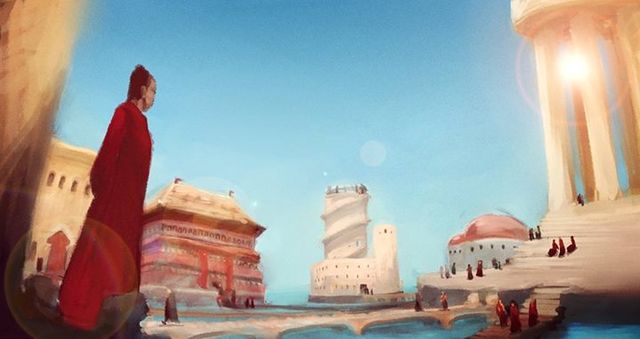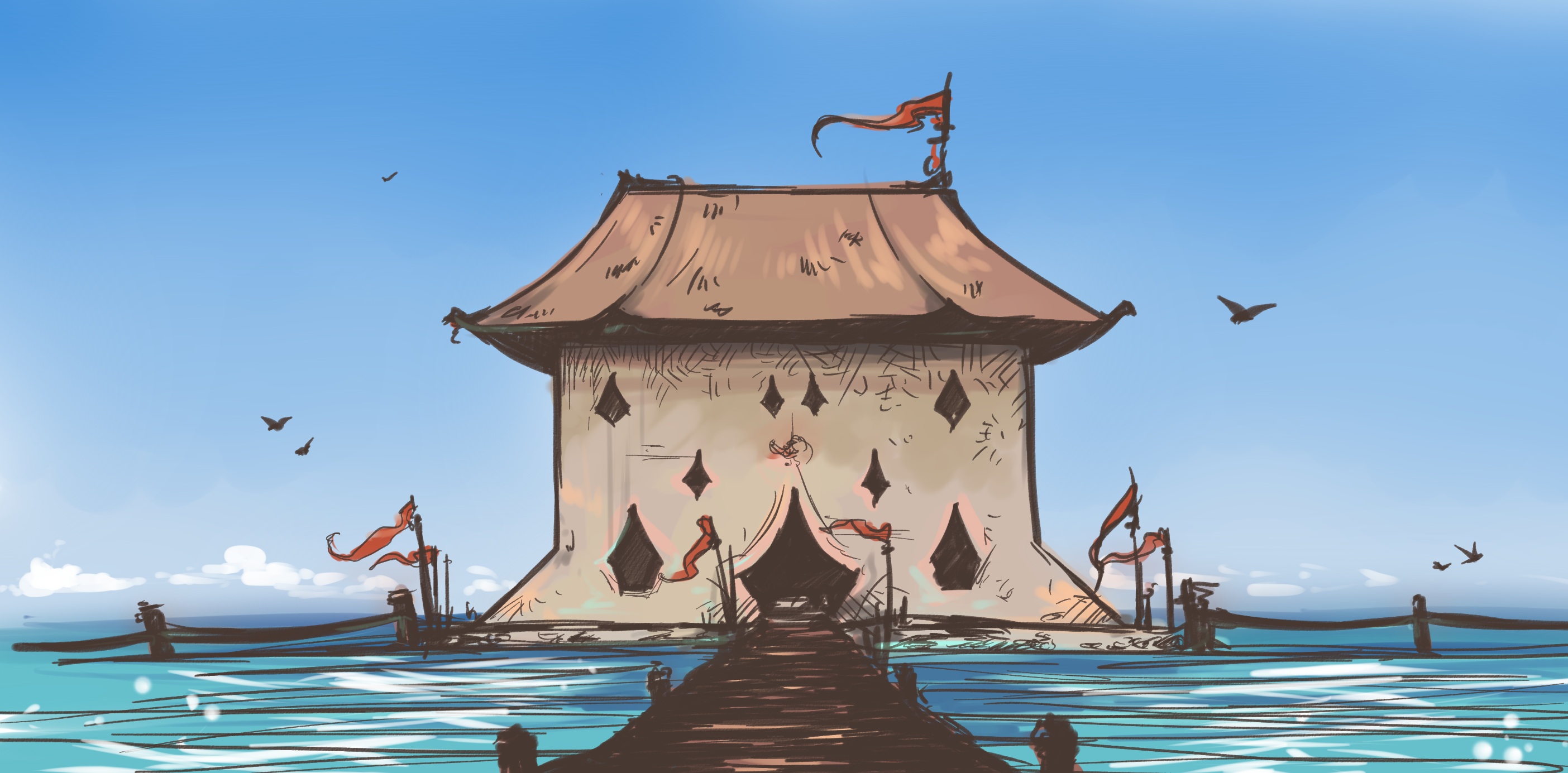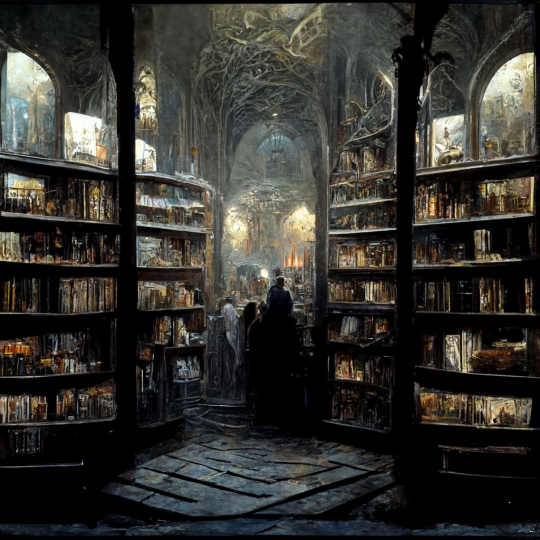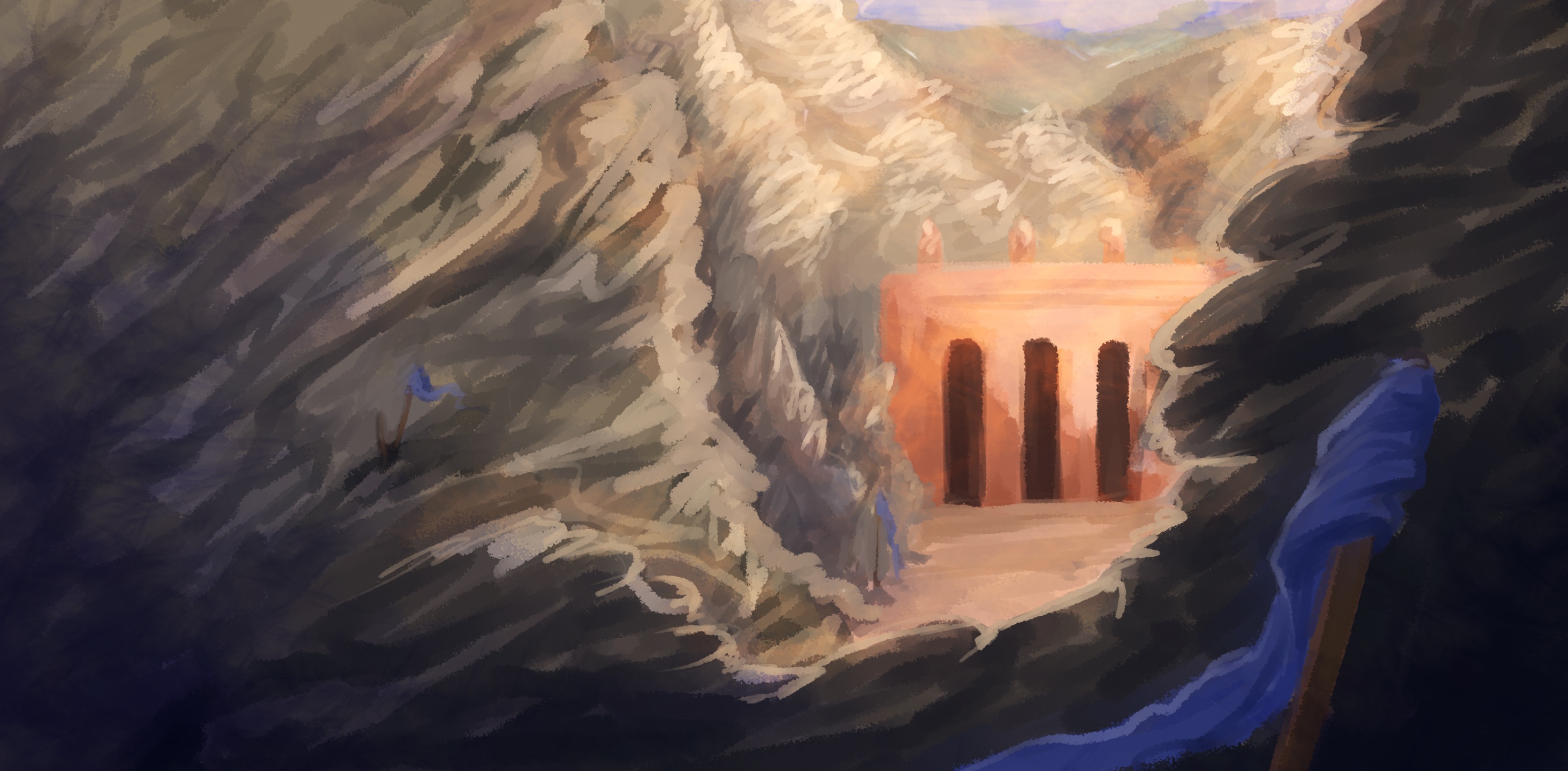Harenis
Introduction
Harenis is the great scholastic city of the Arclands. Whilst being significantly smaller than Arc , it is still a major metropolis and a centre of learning, knowledge and lore. It is built from white stone and sits offshore, a perfect marble circle connected to the land by the Vinderhon Bridge. Harenis is the home to numerous schools and scholastic houses, ranging from the highly prestigious House of Neem to smaller institutions with mixed reputations. The city is divided between a wealthy caste of prestigious scholars and sages, who kings and emperors pay handsomely to consult, and a large and financially precarious class of scribes and researchers who do most of the skilled work that keeps the city’s masters in business. Most of these poorly paid and over worked intellectuals live in the Inktown district of the city. Fifty miles inland, uinder Mount Khest, is the Library of Harenis. This vast archive is the size of a city and fills an enormous chamber carved inside the mountain itself. The library was created by the emperor Dures II as a source of all the world’s knowledge, but is slowly drifted into disorder and chaos.Harenis and the Church
Harenis's wealth, prosperity and status is guaranteed by Arc, which offers the city the use of the Arcish Levat as currency (for more on the value of the Levat read The Levat and Modern Arcish Currency. The reason for this generosity is that Harenis provides a valuable epistemological service for Arc and the Aruhvian Church. As far as the church is concerned, a majority of the scholarship done in Harenis is either irrelevant or dangerous to its shaky hold over official knowledge in Aestis. The most presitigious Harenian scholars have become very comfortable in their relationship with the church and many now do the church's bidding in supressing more dangerous anti Aruhvian concepts. Renegade sages and scribes who have rejected this corrupt arrangement accuse Harenian schools now of being crucibles of ignorance, not knowledge. Principally, the Aruhvian Church insists that all ideas pertaining to magic are discredited and their proponents (of whom there are several in Harenis) are punished. The Church ensures that Harenis survives as an independent state, the Archimandrites of Arc have placed pressure on Protectors to support the Harenian economy and have brought what pressure they can bring to bear on Dran to garrison the city on very favourable terms. The Church also insists that knowledge regarding the ancient Fey kingdoms (that virtually no Arclander has ever heard of) is suppressed and that any lore that pertains to the now shattered Celestial Realm also be hidden. The Aruhviad is full of misleading references to the Fey, describing them as demonic creatures, and whilst scholars who directly quote from the Aruhviad risk their reputations as they stretch the limits of credulity, it has become increasingly clear that the church is now directing many to do so. Some Harenian sages who have taken gold directly from the church have been reduced to little more than propagandists.The History of the Library and the City
Harenians always seem to forget that their gleaming city which sits half a mile offshore and exists just above the white tipped waves, was always an afterthought in the mind of the Vannic Empire which built the city. Dures II reigned over a dramatic growth in learning, culture and knowledge in the Vannic empire in the years -2311 to -2119, as literacy spread and it became essential that he find a home for this vast outpouring of lore. He decided to build the biggest library in the history of the Vannic peoples and created it in the caverns below Mount Khest in the Arching Mountains. This project, that lasted for centuries after his death, attracted the learned of the Van and then the Arc Empires to a new settlement close to the library, at the mouth of the River Haren, Harenis (City on the Haren). The city of Harenis came to be dominated by a number of powerful and influential schools of learning, each specialising in different fields. A ruling body, the Learned Council came to govern the city and each of the masters of houses were represented on it. In the centuries prior to the Sundering, the government of Harenis was relatively straightforward. All houses agreed that the study of magic and anything arcane was forbidden and the idea that there had once been magic in the world had to be ridiculed. Even though there was no magic to utilise anyway, it didn’t stop scholars from finding out the truth. Following the Sundering, it became ever harder to dismiss reports of magic and sightings of unnatural entities. The determination of the Houses to deny the reappearance of magic in the world has slowly eroded their credibility and they cling to their beliefs because they fear what the widespread adoption of magic might mean to their power and authority. Scholars in Harenis see themselves as the gatekeepers of knowledge and want to tightly control what lore is accepted and what must be banned. They have close ties with the Aruhvian Church, which similarly has no desire to see magic proliferate. The de facto ruler of Harenis is Lord Valis, the master of the House of Neem, the main school of learning for the understanding of natural and ‘earthly’ things. Valis is a bitter, scheming and power hungry man with secret ties to Dran. He is suspicious of his more talented and ambitious underlings and often seeks to undermine them. Harenis is garrisoned by a company of Dranian soldiers that have been seconded to protect the city (at a price). They complement the Circle Watch, a local militia of lazy and incompetent guards who are nornally hired from Vinderhove.The Circles
Harenis is built around ten concentric circles, with the city’s main schools and centres of learning in the first circle. The second to the fifth circles are made up of mainly residential districts with assorted marketplaces and a few inns (Harenis is a notoriously bad place to buy a drink). The outer circles are made up of rougher, less gentrified districts and are close to the very lightly patrolled docks. It is at these waterfronts that more secretive visitors drift anonymously into the city in search of knowledge and power. Right at the heart of the city, separated from the first circle by water is the Resonance. It is the great debating chamber of Harenis and the place where the most important philosophical debates in Aestis have been held. It sits at the heart of a perfectly symmetrical circular city some scholars have wondered whether the Resonance might have some other hidden purpose.The Schools
There are Nineteen great scholastic houses in Harenis. The House of Neem, Dorus, Mastrande, Tharis, Aldroun, Drevantin and Khoruvel are the most famous and prestigious. They populate the most attractive parts of the First Circle, surrounding the Resonance. Behind these schools in the adjoining side streets are the lesser well known centres of learning which are smaller; Neem has over three hundred scholars and scribes when it is full, a lesser school might have twenty. Those scholars who cannot afford to pay for the expensive tuition and knowledge at a great scholastic house or even a lesser one, tend to group together in small ‘scroll houses’. These consist of several scholars in the same field pooling all their resources and their meagre finances, living on top of one another in cramped accommodation. Often these arrangements end in drink fuelled violence. For the wealthy, gaining access to a great school is easy, money opens all doors in Aestis eventually. For the poor, the only hope is some kind of scholarship or charity, which some of the houses offer periodically. Those who wish to study at a great scholastic house need to show that they are intelligent enough; scholars normally have a specific thing they wish to learn (ancient Vannic law, the history of Del’Marah for example).Places of interest
Makara’s Market
A bustling bazaar famous for its liquorice and hot chicory stalls and a good place to pick up a bootlegged version of an expensive book. Though most of the work is done by the urban poor and their children some students at the library make money on the side transcribing sections of books considered overly complex, specific or rare. One of the best known features of the market is Redvyre's Corner. Elther Redvyre is a dislikeable and obnoxious hoarder of books, scrolls and knowledge and is very selective about who he chooses to sell his merchandise to. He occupies one large corner of the market and has built a maze of tents and book stalls. He delights in helping desperate scholars to find rare texts and then refusing to sell them at any price. When he is not engaged in casual sadism towards the desperate, Redvyre takes his responsibilities as a protector of lore seriously and is constantly on the look out for Mordikhaani spies searching for precious texts. He is more than a little paranoid as a result.Poru Square
Home of the Thinker of Harenis, a 20-foot bronze statue believed to represent the philosopher Edru (Though some claim Okorad of Van), it is often a focal point of violence in the city among acolytes and pilgrims but also a centre for most of the feast times and city wide celebrations.The Ink Maker’s Quarter/Inktown
Ink makers are considered to be undesirable types in Harenis. The smelly work of extracting inks from shellfish and dye and paint making mean the area is walled off and monks patrol the perimeters with censers selling nosegays. The chemicals used in the ink and paint making processes tend to leave their makers ill and often tortured by irritating skin conditions making Inktown downbeat and depressing place. Out of work Ink Makers are usually addicted to imbibing solvents and can usually be employed to carry out nefarious tasks by their lofty masters the Inklords who live in the first circles and never visit Inktown unless necessity demands it. The district is also considered a very good way of sneaking into the city unobserved as the Inkmen have access to the ports to collect cuttlefish shipments and the wall near Inktown is seldom properly patrolled.The Library of Harenis
Situated at the east face of the foot of Mount Khest is the Durean Gate to the Library of Harenis. The library is the single largest space ever built by the Van; it fills a chamber the size of a city deep under the mountain. Some have speculated that the library itself is the size of Arc, but no one really knows, as centuries have passed the archivists who acted as wardens in the vast library have slowly grown fewer in number. What is clear is that the order that the library was once famed for has slowly decayed into growing chaos. The library’s floor is made up of hundreds of square miles of lacquered wood and the books, scrolls, maps and other items are housed in gigantic storage units called stacks. These are book cases the size of three story houses that are so huge the archivists have to step inside them to access the book they are looking for. Each book in the library can be found through a complex series of sigils written in its spine and the ‘aisles’ between each stack are as wide and long as roads. At the heart of the Library is a huge circular plaza with a run down citadel in the centre. It is here that the Map Makers live, a secret order of reclusive Harenian scholars who have dedicated their lives to mapping both the world they inhabit, but more importantly, the library itself. They have concluded something most interesting about the library over the centuries; the stacks and the aisles seem to move over time and new maps need to be created. Some of the more radical thinkers among the Map Makers have come to believe that the library itself is alive. Travel in the library is difficult, many of the main aisles are lit by lamp, but entire districts have been plunged into darkness for years as there are so few Archivists to keep the lamps lit. The Map Makers and Archivists fear that they are not alone in the dark; in the library, far away from the power of the Harenian scholars, the inhabitants are able to discuss the basic truth of magic and dimensional beings. It has long been suspected that there are portals to other realms and realities in the library and scholars have become ever more fearful about what lurks in the dark and the dust. Do you want more lore? Get weekly updates on World Anvil and the Arclands Blog straight to your email inbox, PLUS our list of fifty mysterious trinkets to delight and enchant your adventuring party. Get your copy here.A Fire in the Heart of Knowing
Our debut Arclands novel is available here. Read A Fire In the Heart of Knowing, a story of desperate power struggles and a battle for survival in the dark lands of Mordikhaan.From the writings of Mordei Morhanan on Harenis
"...When the Vannic Empire ruled, it stretched from its citadels above the clouds in the peaks of the Arching Mountains all the way to the northern shores of the Greater Arc Sea. The Van controlled the heart of Aestis and ignored the eastern and western Arclands as lands of untameable savagery. They saw themselves as the link between the heavens and the earth, and were so enamoured with themselves and their own civilisation that they committed all they knew to parchment; anyone who knows the history of the Van will tell you that parchment is power. Schools of learning sprung up across the empire during the reign of Dures II, Emperor of the Mount, and during the four decades of his reign and the shorter, less glorious rule of his son and grandson, a vast library was built. So grand and audacious was this project that it took an army of the Van Empire's master craftsmen servants, the Firg, nearly a century to complete. The library was built at the foot of Mount Khest and its many vast chambers spread deep into the mountain, growing to the size of the great cities of the Arc Sea. It was claimed by the Del Marahan seer Mois Trar that a man could spend a lifetime in the library and barely read a fraction of what was stored there; the Van had put in one place all the world's learning and they safeguarded it jealously. Many scholars who trekked from across the known world to read the secrets and knowledge of the Van found life under the mountain unbearable, and so some of them established the city of Harenis on an archipelago of islands along the southern Arc Sea coastline, some fifty leagues from the library. As the Van Empire collapsed and its successor empire in the great city of Arc brought order to the continent, Harenis thrived under its new protector. Harenis became a seat of learning and knowledge for generations of scholars and sages, and the city's white marble schools sat just above the waves. Harenian scholars for centuries have lived in the city but looked to the mountain with a mixture of fascination and fear, knowing in their hearts that in its chambers lie the secrets they hunger for, but also in the darkness lies a fate of obsession that has seen many of their number disappear into the shadows of the library and never return…" From 'The writings on histories of arcanism, magickes, fables and histories of the peoples of Aestis' by Mordei Morhannan of the School of Dorus.
Scholastic cities can be amazing places to establish campaigns around. They are centres of learning and lore, where obscure secrets, forgotten ideas and buried truths can only be uncovered by wise and dedicated characters. They offer a chance to investigate the past and the present and can direct players towards new quests. In the Arclands setting, the scholastic city of Harenis is the nearest thing Aestians have to our world’s great library of Alexandria. It is a pristine white marble city built offshore on an atoll, battered by frequent monsoons. Fifty miles inland is the great Library of Harenis, which is contained inside a mountain chamber and is itself the size of a city. You can find out more about Harenis from the links in this article, but below is a list of ten items you can find in a Harenian library (feel free to adapt these to your own campaigns too).
Ratheker oil
Ratheker oil is a pungent substance used in burial rituals across the Arclands. It is normally dripped on the eyelids of the deceased, in order that the tranquility, which is said to be a property of the oil, seeps into the body where the sleeping soul resides. The oil then helps to transport the deceased on their journey to the afterlife, or so it is believed. Ratheker oil can also be used in many other ways, some scholars inhale it in order to plunge themselves into deathlike trances where they have access to knowings that are far beyond anything the conscious mind can understand. A jar of Ratheker oil in the study of a scholar or sage is a powerful clue that its owner has experimented with radical and forbidden ways of acquiring knowledge and might not be all that they seem.Marliks orb
The craftsman Odrean Marlik of the Dures Road in Arc eventually went mad creating works of such extraordinary beauty, and in his life he made twenty seven orbs which collectors seek and will pay a high price for. To the untrained eye, the orb is simply a glass sphere, but inside, Marlik has etched almost indecipherable sigils into the crystal itself. When the orb is held up to the setting sun, the crystal within the orb shimmers as if gold dust were trapped in suspension and the sigil is momentarily visible. It is rumoured that the words have a great power and are in the lost language of Old Vannic. Some collectors seeking all twenty seven orbs have been driven insane by the quest, just as Marlik himself was.Solunite candles
The Solunites are warrior monks who live in deep caves in the depths of the Kheyun Marshes. They are also the makers of extraordinary candles which have a luminescence unmatched by any other type of candle in Aestis. The wax is suffused with the sap of the Agwaera, a tall black tree that grows underground and which gives off a pale blue light from its leaves, feeding all manner of strange creatures in the dark of the caves where the Solunites live.Del’Marahan silk robes
Del’Marahan silk is unmatched in quality anywhere across the Arclands. The wearer of these robes is a person of immense taste and refinement and one who has probably not been adventuring in many years.Firg cane
The Firg are the greatest craftsmen in Aestis, a giant folk whose understanding of weapon smithing is unmatched. Whilst they rarely make weapons specifically for humans, when they do, the result is both functional and beautiful. The Firg cane resembles a three foot carved white wooden walking cane, but it conceals a slender, razor sharp blade. Instead of drawing the weapon from a sheath, the blade swings open, similar to a pocket knife. The weapon can be used either as a sword when opened at 180 degrees or a scythe when it is opened at 90 degrees.Hothian harp
If Harenis is the intellect of Aestis, Hothis is its soul. The city is where skalds, poets and minstrels find their deepest inspiration, and a harp from Hothis has often been played by some of the greatest musicians in the world. It is rumoured that Hothian harps are more than simply musical instruments, and instead they are a way of keeping secrets. Some have been known to be enchanted, and if the right strings are plucked in the right order, a message or a vision that is kept within the harp itself is revealed to the harpist.Carathene maps
The Carathene Monks are an order who saw it as their task to map the known world, in order to pay homage to the Keeper, the god they imagined created the world of Hermia. The maps your players might find, however, could bear no resemblance to anywhere in Hermia at all. In fact, they might look like somewhere that could or should not exist at all.Hostari water skins
Some scholars do leave the confines of their chambers periodically, and whilst travelling overland, few items are as useful as the robust Hostari water skin. The riders of the Hostar Plains drape them over their saddles and the cured leather preserves water for longer than any other receptacle.Dranian armour
do not give up their armour lightly, the breastplate, greaves, shield and hauberk of the warlike city of Dran, known also as the ‘Hammer of the East’, suggest something intriguing about their owner. Some Dranian warriors after many years of conflict have been known to hang up their sword eventually and retire to a scholastic life, finding meaning in knowledge, not conquest.Swithick snout
Harenian scholars are often heavy pipe smokers and will import tobacco from across the continent. Sometimes heavy, aromatic brakkha (cigars) from Del’Marah are found in a Harenian study, but often the cheaper but no less addictive Swithick snout. The blue smoke of the pipe tobacco often combines with the parchment dust to create a thick ‘scriveners smog’ in the libraries of Harenis.
Type
Large city






Comments